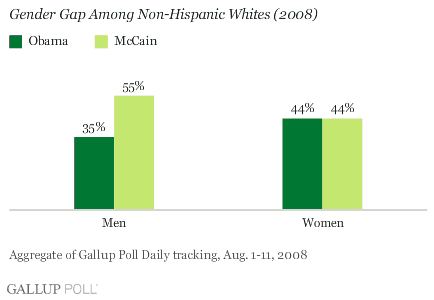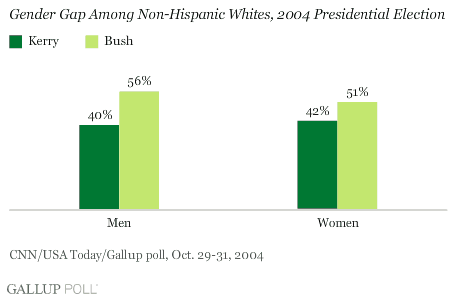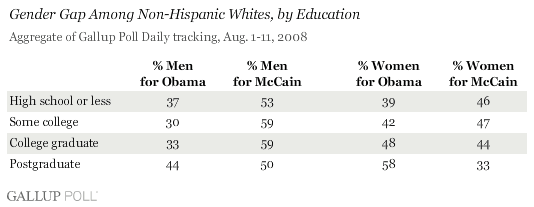PRINCETON, NJ -- John McCain continues to have a significant advantage over Barack Obama among non-Hispanic white males while doing much less well among white females -- winning among the former by a 20-point margin, while only tying Obama among the latter.

This finding, based on Gallup Poll Daily tracking interviews with more than 8,200 non-Hispanic white registered voters conducted between Aug. 1 and Aug. 11, shows that McCain now does slightly better among white men compared to George W. Bush's final position against John Kerry in the 2004 election. But McCain is doing worse among white women. The net effect of this expanded gender gap is to give Obama a slightly better position among whites than was the case for Kerry in 2004.
The Gender Gap Among Whites in Historical Perspective
Democratic presidential candidates have generally done less well among white men than among white women in recent elections. But the gap between the two genders among whites is significantly larger this year than it was in 2004. In Gallup's final poll of registered voters in late October 2004, Kerry trailed Bush by 9 points among non-Hispanic white women and by 16 points among non-Hispanic white men. That produced a 7-point gender gap, about one-third the size of this year's 20-point gap.

McCain's relative advantage among men is slightly better this year than was Bush's in 2004. But McCain has lost ground to Obama among white women; Bush's 9-point lead over Kerry among this group four years ago has evaporated.
The larger gender gap overall is giving Obama a modest boost compared to the final positioning of the 2004 candidates. In Gallup's late October 2004 poll, Kerry was behind Bush by 12 points among non-Hispanic white registered voters. This year, Obama is down to McCain by a modestly smaller 9-point margin. Obama's gains among white women more than compensate for his slight loss of positioning among white men.
Education
The impact of education in patterns of support for Obama and McCain plays out differently between white men and white women.

Among men, McCain leads regardless of education. He does particularly well among white men with some college and those who are college graduates, slightly less well among those who have high school educations or less, and least well among white men with postgraduate educations (among whom he wins by just 6 points).
The pattern is somewhat different among non-Hispanic white women. Obama trails McCain by 7 points among white women with high school educations or less, and then does progressively better among those with higher levels of formal education. Obama beats McCain by a slight margin among white women who are college graduates. Remarkably, Obama has a very large 25-point margin among white women with postgraduate degrees.
Implications
The slightly weaker position for McCain vis-à-vis Obama among whites is not a major shift, but does represent a loss for McCain compared to his fellow Republican's performance among whites in 2004.
The data reviewed here show that the explanation lies with Obama's stronger showing among white women. Whereas Bush led Kerry by 9 points among white women in 2004, McCain and Obama are now tied among this group. This gain by Obama is partially mitigated by the fact that he does slightly less well among white men than did Kerry, but the net impact of the widening gender gap overall is a gain for Obama among whites.
There has been much talk about Obama's relative problems this year in reaching white men, particularly those with less than a college education. The data reviewed here from early August show that Obama in general does indeed trail McCain significantly among white men, particularly those who have a college degree or less. This white male deficit appears to be slightly larger than it was for Kerry in 2004. But Obama's relative strength among white women, particularly those with postgraduate educations, has to this point more than made up for his deficit among white men.
Survey Methods
Results are based on telephone interviews with 9,817 registered voters, aged 18 and older, conducted Aug. 1-11, 2008, and 8,208 registered voters who are non-Hispanic whites. For results based on both of these samples, one can say with 95% confidence that the maximum margin of sampling error is ±1 percentage point, with larger margins of sampling error among subgroups.
Interviews are conducted with respondents on land-line telephones (for respondents with a land-line telephone) and cellular phones (for respondents who are cell-phone only).
In addition to sampling error, question wording and practical difficulties in conducting surveys can introduce error or bias into the findings of public opinion polls.
To provide feedback or suggestions about how to improve Gallup.com, please e-mail feedback@gallup.com.
